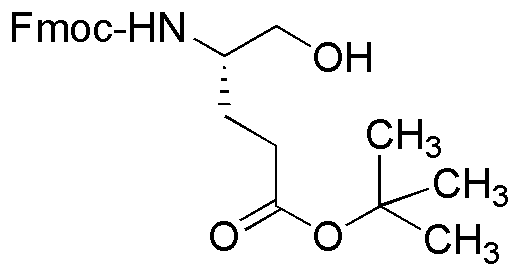Fmoc-g-tert-butyl ester-L-glutamol is widely utilized in research focused on:
- Peptide Synthesis: This compound serves as a protecting group in the synthesis of peptides, allowing for selective reactions. Its stability under various conditions makes it a preferred choice for researchers in organic chemistry.
- Drug Development: It plays a crucial role in the development of pharmaceutical compounds, particularly in creating prodrugs that enhance bioavailability and therapeutic efficacy.
- Bioconjugation: The compound can be used in bioconjugation processes, facilitating the attachment of biomolecules to drugs or diagnostic agents, which is essential in targeted therapies.
- Research in Neuroscience: Its derivatives are explored in studies related to neurotransmitter systems, contributing to the understanding of neurological disorders and potential treatments.
- Material Science: The compound is also investigated for its properties in developing new materials, particularly in creating polymers with specific functionalities for biomedical applications.
General Information
Properties
Safety and Regulations
Applications
Fmoc-g-tert-butyl ester-L-glutamol is widely utilized in research focused on:
- Peptide Synthesis: This compound serves as a protecting group in the synthesis of peptides, allowing for selective reactions. Its stability under various conditions makes it a preferred choice for researchers in organic chemistry.
- Drug Development: It plays a crucial role in the development of pharmaceutical compounds, particularly in creating prodrugs that enhance bioavailability and therapeutic efficacy.
- Bioconjugation: The compound can be used in bioconjugation processes, facilitating the attachment of biomolecules to drugs or diagnostic agents, which is essential in targeted therapies.
- Research in Neuroscience: Its derivatives are explored in studies related to neurotransmitter systems, contributing to the understanding of neurological disorders and potential treatments.
- Material Science: The compound is also investigated for its properties in developing new materials, particularly in creating polymers with specific functionalities for biomedical applications.
Documents
Safety Data Sheets (SDS)
The SDS provides comprehensive safety information on handling, storage, and disposal of the product.
Product Specification (PS)
The PS provides a comprehensive breakdown of the product’s properties, including chemical composition, physical state, purity, and storage requirements. It also details acceptable quality ranges and the product's intended applications.
Certificates of Analysis (COA)
Search for Certificates of Analysis (COA) by entering the products Lot Number. Lot and Batch Numbers can be found on a product’s label following the words ‘Lot’ or ‘Batch’.
Numéro de catalogue
Numéro de lot/série
Certificates Of Origin (COO)
This COO confirms the country where the product was manufactured, and also details the materials and components used in it and whether it is derived from natural, synthetic, or other specific sources. This certificate may be required for customs, trade, and regulatory compliance.
Numéro de catalogue
Numéro de lot/série
Safety Data Sheets (SDS)
The SDS provides comprehensive safety information on handling, storage, and disposal of the product.
DownloadProduct Specification (PS)
The PS provides a comprehensive breakdown of the product’s properties, including chemical composition, physical state, purity, and storage requirements. It also details acceptable quality ranges and the product's intended applications.
DownloadCertificates of Analysis (COA)
Search for Certificates of Analysis (COA) by entering the products Lot Number. Lot and Batch Numbers can be found on a product’s label following the words ‘Lot’ or ‘Batch’.
Numéro de catalogue
Numéro de lot/série
Certificates Of Origin (COO)
This COO confirms the country where the product was manufactured, and also details the materials and components used in it and whether it is derived from natural, synthetic, or other specific sources. This certificate may be required for customs, trade, and regulatory compliance.


